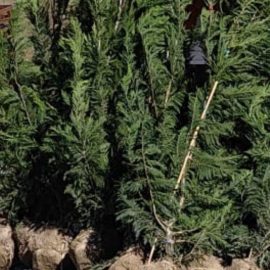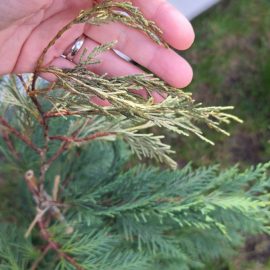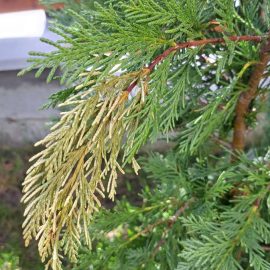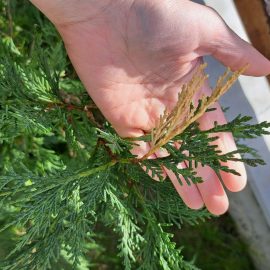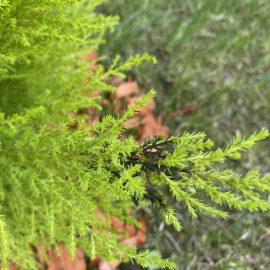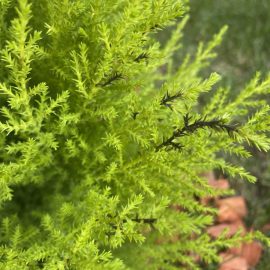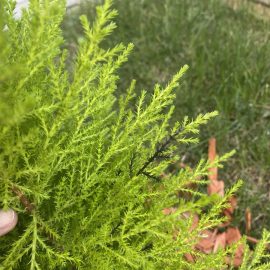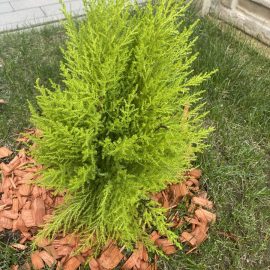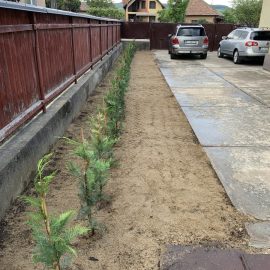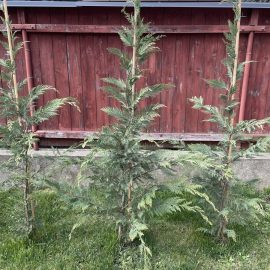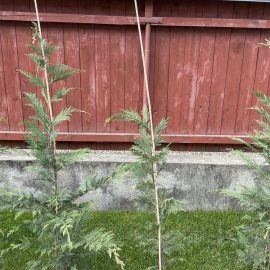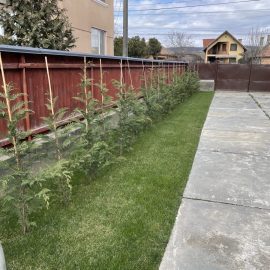Cypress, planting guide and care work
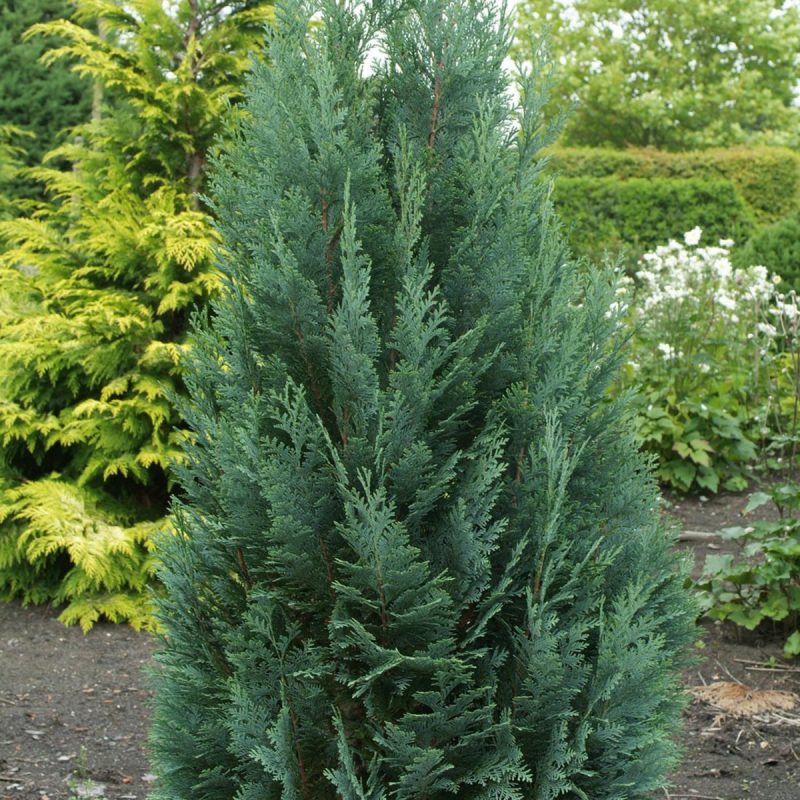
Chamaecyparis (cypress) is a genus of coniferous trees in the Cupressaceae family, native to East Asia and North America. They are medium or large trees, with heights of up to 20-70 m. In general, the branches are flattened, arranged on a single level. It has two types of leaves: acicular – in young specimens and scaly – in trees older than one year. The cones are globular and have 8-14 scales containing 2-4 seeds each. They are planted as ornamental trees in parks and gardens, as solitary specimens, or in groups. Some species withstand pruning in the form of hedges.
Species and cultivars
Chamaecyparis lawsoniana (Port Orford cedar)
It is native to North America, where it grows to size I, reaching a height of 60 m. It has an elegant overall appearance and it develops a pyramidal and narrow crown. The trunk is covered with branches to ground level and the top is bent. It branches on a single level and has very rich foliage. The leaves are small, scaly, dark green, with shades of gray-blue. The cones grow abundantly on the branches, are spherical, and have a very small size (8 mm). These are green at first, then turn purple, and at maturity are brown. Cultivars:
- ‘Alumii’ – it reaches 10-12 m; it has a narrow, column-like crown, with leaves in shades of blue.
- ‘Columnaris’ – it can reach a height of 10 m; it has the shape of a column, with straight, upward-oriented branches and leaves in shades of blue.
- ‘Ellwoodii’ – it develops a conical crown, with thick foliage; it reaches a height of 4-5 m.
- ‘Lane’ – it reaches a height of 5-7 m and it has golden-yellow leaves.
Chamaecyparis nootkatensis (Nootka cypress)
It is a size I tree, native to Alaska and the N-E part of North America. It develops a pyramidal crown, narrow, with bent branches. It is branched on a single level. The foliage is thick, dark green, with rough, scaly leaves. The cones are larger than in the case of the previous species – 1 cm long. Cultivars:
- ‘Pendula’ – it is a size III tree, with horizontally arranged branches and droopy shoots.





Chamaecyparis obtusa (Hinoki cypress)
It is a tall tree in its natural environment, but in some countries, there are shorter cultivars:
- ‘Nana gracilis’ – it has a height of 2-3 m, forms a conical crown at maturity, with fan-shaped branches. The foliage is dark green, glossy.
- ‘Nana’ – a shrub with a height of 0.6 m, with a spherical and compact crown.
Chamaecyparis pisifera (Sawara cypress)
It is a tall tree, but in some countries, small cultivars are usually planted:
- ‘Filifera’ – it forms a wide, conical crown and it grows to a height of 5 m. The shoots are silver, pendant, with acicular leaves in shades of blue.
- ‘Plumosa’ – it reaches a height of 10 m; it has acicular leaves, which turn brown during the cold season.
- ‘Plumosa aurea‘ – it has golden-yellow leaves.
- ‘Squarrosa Boulevard’ – it has leaves with intense shades of silver-blue all year round.





Environmental conditions
Light. Cypress trees prefer bright or partially shaded places to develop intensely colored foliage. However, strong sunlight can cause sunburn.
Temperature. In general, Cypress trees are sensitive to frost and cold winds in the first years. Japanese cypress trees need shelter during the cold season and prefer a mild climate. On the other hand, the Nootka cypress is a frost-resistant species.
Soil. It grows optimally in damp, aerated soils and does not tolerate prolonged drought.
Pruning
Shape correction cuts are not necessary, except in the case of the C. lawsoniana species – to obtain high hedges.
Fertilization
In order to stimulate the rich growth of trees and shrubs, during the vegetative growth period, it is recommended to apply specific fertilizers.
Recommended products
-
You can find products on a different store
Change Store -
You can find products on a different store
Change Store -
You can find products on a different store
Change Store -
You can find products on a different store
Change Store -
You can find products on a different store
Change Store -
You can find products on a different store
Change Store -
You can find products on a different store
Change Store -
You can find products on a different store
Change Store -
You can find products on a different store
Change Store -
You can find products on a different store
Change Store -
You can find products on a different store
Change Store -
You can find products on a different store
Change Store -
You can find products on a different store
Change Store -
You can find products on a different store
Change Store -
You can find products on a different store
Change Store -
You can find products on a different store
Change Store -
You can find products on a different store
Change Store -
You can find products on a different store
Change Store -
You can find products on a different store
Change Store -
You can find products on a different store
Change Store -
You can find products on a different store
Change Store -
You can find products on a different store
Change Store -
You can find products on a different store
Change Store -
You can find products on a different store
Change Store
Planting
It can be done in spring or autumn, during the vegetative dormancy period, at temperatures above 5° C, if the soil is not frozen and there is no danger of frost. Make sure you buy the planting material from authorized nurseries. Immediately after planting, water abundantly, then keep the soil always moist.
Propagation
Cypress trees can be propagated through seeds, cuttings, or grafting.
- through seeds: the cones should be harvested in autumn, before they open, and the seeds have to be sown immediately afterwards. Plants obtained from seeds have a slow growth.
- through cuttings: it is done in July-August, in nurseries or greenhouses, using terminal shoots.
- grafting is used less often, when cuttings do not work.
Diseases and pests
The pests that can infest Cypress trees are aphids. Diseases that can affect Chamaecyparis are Berckmann’s Blight – it leads to the necrosis of branches from outside to the inside, after which the plants dry out.
In addition:
- it is recommended to keep a portion free of grass or weeds at the base of the plants.
- dwarf forms are used in rockeries with ground cover plants.
- it does not tolerate calcareous soils well.
- in optimal conditions, chamaecyparis have a longer longevity.
- in nootka cypress, the cones mature in the second year.














































































































































































































































































































































































































































